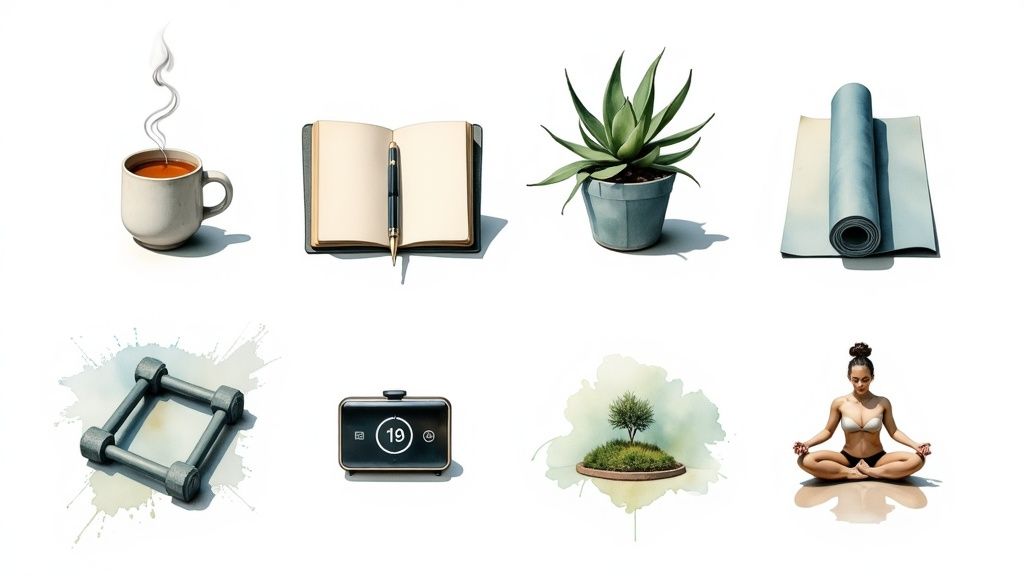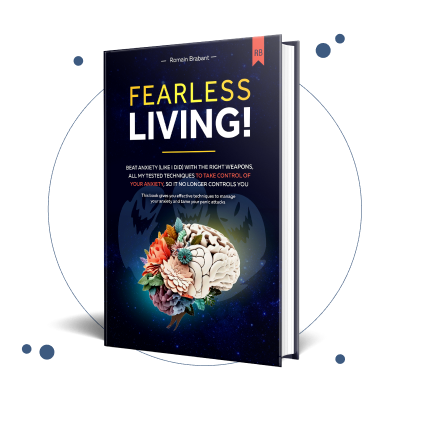
Anxiety can feel like a relentless storm, trapping you in a cycle of overwhelming worry and physical tension. It may whisper that this is your permanent reality, but that is a lie. Hope is not just a vague feeling; it is a concrete strategy, and you have the power to heal. A life free from the constant grip of panic isn't just possible; it is achievable. This guide is your first step on that path, offering a detailed map to move beyond mere survival and into a state of thriving.
We are about to explore a comprehensive toolkit of eight powerful, evidence-based coping mechanisms for anxiety. This is not a collection of generic advice. Instead, you will find practical, actionable strategies designed to dismantle anxiety at its core. From cognitive reframing techniques and mindfulness practices to strategic lifestyle adjustments and building robust support systems, each item is a vital piece of your healing journey. We will provide clear, step-by-step instructions and real-world examples to help you integrate these tools into your daily life immediately. Your journey to reclaiming your peace, control, and joy begins now. Let's start building your panic-free life, one effective strategy at a time.
1. Deep Breathing and Progressive Muscle Relaxation
Anxiety often manifests physically, triggering a "fight or flight" response that includes a racing heart, shallow breathing, and tense muscles. One of the most direct and powerful coping mechanisms for anxiety is to address these physiological symptoms head-on. Deep breathing and Progressive Muscle Relaxation (PMR) are techniques designed to activate the body's parasympathetic nervous system, which acts as a natural brake on the stress response, guiding you toward a state of calm and offering hope that you can regain control and live panic-free.
This approach works by consciously shifting your body from a state of high alert to one of rest. Controlled breathing slows your heart rate, while PMR involves systematically tensing and then releasing different muscle groups to alleviate physical tension you might not even realize you're holding. This physical release sends a powerful signal to your brain that the perceived danger has passed, proving that you can actively manage your body's response to anxiety.

How to Implement This Technique
This method is highly versatile. It can be used preemptively to manage daily stress or reactively at the onset of anxious feelings. For example, military personnel use tactical breathing to stay calm before missions, and healthcare workers employ these techniques for a quick reset during stressful shifts. These skills are learnable, effective, and a first step in proving you can influence how you feel.
Actionable Tips:
- Practice 4-7-8 Breathing: Inhale through your nose for a count of 4, hold your breath for a count of 7, and exhale slowly through your mouth for a count of 8. This popular technique was advanced by Dr. Andrew Weil.
- Focus on the Exhale: Making your exhalation longer than your inhalation is key to stimulating the vagus nerve and activating the relaxation response.
- Start Small: Dedicate just 5-10 minutes each day to practice. Consistency is more important than duration, especially when building the habit that leads to lasting change.
- Try Guided Sessions: Use apps like Calm or Headspace, or follow along with guided videos to learn the proper form for PMR and breathing.
For a deeper dive into various methods, you can explore these powerful breathing exercises for anxiety.
2. Cognitive Behavioral Therapy (CBT) Techniques
Anxiety often feels like an uncontrollable force, driven by a cycle of negative thoughts that fuel fear and physical symptoms. Cognitive Behavioral Therapy (CBT) offers a structured and evidence-based approach to break this cycle. It operates on the principle that our thoughts, feelings, and behaviors are interconnected, and by changing our negative thought patterns, we can change how we feel and react, providing a clear path toward managing anxiety and reclaiming a sense of peace.
This powerful coping mechanism for anxiety teaches you to become an objective observer of your own mind. You learn to identify, challenge, and reframe the distorted or catastrophic thoughts that trigger your anxiety. Rather than being swept away by fear, CBT equips you with practical skills to question the validity of your anxious thoughts. This is a profound realization: your thoughts are not facts, and you can learn to separate from them, paving the way for a life unburdened by constant panic.

How to Implement This Technique
CBT techniques can be applied in the moment to de-escalate rising panic or used as an ongoing practice to build long-term resilience. For instance, a person with social anxiety might use a thought record after a party to challenge their belief that everyone was judging them, while someone with a phobia might use exposure therapy with a therapist to gradually face their fears in a controlled way. This is how healing happens—step by manageable step.
Actionable Tips:
- Keep a Thought Diary: Regularly jot down triggering situations, the automatic negative thoughts that arise, and the feelings they cause. This helps you recognize your unique anxiety patterns.
- Use the "Best Friend Test": When a worry takes hold, ask yourself, "What would I tell my best friend if they had this exact same fear?" This promotes a more compassionate and rational perspective.
- Challenge Your Thoughts: Act like a detective and search for evidence. Ask yourself: "What is the evidence that supports this anxious thought? What is the evidence against it?"
- Try Behavioral Experiments: If you fear a specific outcome (e.g., "If I give this presentation, I will forget my words and be humiliated"), treat it as a testable hypothesis. Afterward, analyze the actual results. You'll often find the reality is far kinder than the fear.
For a comprehensive guide, explore these powerful Cognitive Behavioral Therapy (CBT) techniques for anxiety.
3. Mindfulness Meditation
Anxiety often traps us in a cycle of worrying about the future or ruminating on the past. Mindfulness meditation, a practice rooted in ancient traditions, offers a powerful way to break this cycle. It teaches you to pay deliberate, non-judgmental attention to the present moment, helping you observe anxious thoughts and sensations without getting entangled in them. This creates a crucial space between you and your anxiety, proving that your thoughts do not have to control you and that a calmer, panic-free existence is achievable.
This technique works by training your brain to stay grounded in the now. Instead of being swept away by a "what if" scenario, you learn to simply notice it as a thought, like a cloud passing in the sky. This practice of observation without reaction weakens the power anxiety holds over your mind and body, gradually reducing the intensity of the "fight or flight" response and fostering a sense of inner peace and control. It offers hope that you can find stillness even amidst the storm.

How to Implement This Technique
Mindfulness is not about stopping your thoughts but changing your relationship with them. It can be practiced formally through seated meditation or informally by bringing awareness to daily activities. For example, Google’s "Search Inside Yourself" program successfully uses mindfulness to reduce employee stress, while military veterans utilize it to manage symptoms of PTSD and anxiety, demonstrating its effectiveness in high-stress environments and its power to heal.
Actionable Tips:
- Start Small: Begin with just 5 minutes of guided meditation each day using apps like Insight Timer or Headspace. Consistency is the key to building this mental muscle.
- Practice Mindful Moments: Choose a routine activity like drinking your morning coffee or walking to your car. Pay full attention to the sensory details: the taste, the sounds, the feeling of your feet on the ground.
- Use the RAIN Technique: When a strong emotion arises, practice this four-step process: Recognize what you're feeling, Allow the feeling to be there, Investigate it with curiosity, and Non-attachment (let it pass without identifying with it).
- Find Community: Join a local mindfulness group or an online community for support and shared practice.
To explore this practice further, you can discover more about mindfulness meditation for anxiety and how it can become one of your most reliable coping mechanisms for anxiety.
4. Regular Physical Exercise
When anxiety takes hold, it can feel like you're trapped in a cycle of worry and nervous energy. Physical activity acts as a powerful natural anxiolytic, or anti-anxiety treatment, offering a direct route to disrupt this cycle. It works by releasing mood-boosting endorphins, reducing stress hormones like cortisol, and giving a productive outlet for pent-up tension, providing a tangible way to fight back against anxious feelings and reclaim a sense of calm.
This approach fundamentally changes your brain and body chemistry to combat anxiety. As neuroscientist Dr. John Ratey explains in his book "Spark," exercise physically remodels the brain, promoting the growth of new neurons and strengthening the circuits that regulate mood and stress. This process offers profound hope, demonstrating that you can actively reshape your brain's response to anxiety and build lasting resilience, empowering you to heal yourself from the inside out.

How to Implement This Technique
Integrating exercise as one of your coping mechanisms for anxiety doesn't require training for a marathon. The goal is consistent, mindful movement. For instance, running clubs designed for individuals with mental health challenges create a supportive community, while yoga studios offering trauma-informed classes provide a safe space to connect mind and body. Even corporate wellness programs have shown that encouraging physical activity leads to reduced stress claims among employees.
Actionable Tips:
- Start Small and Build Momentum: Begin with just 10-15 minutes of walking each day. The key is to create a sustainable habit you can gradually increase over time. Every step is progress.
- Find an Activity You Genuinely Enjoy: Consistency is crucial. Whether it's dancing, hiking, swimming, or team sports, choosing something you love ensures you'll stick with it.
- Take It Outdoors: Exercising in nature, when possible, provides a double benefit. Sunlight and fresh air have their own mood-enhancing effects that can amplify the benefits of the physical activity itself.
- Track Your Mood: Note how you feel before and after you exercise. Seeing a clear pattern of improvement can be a powerful motivator to keep going on difficult days.
5. Social Support Networks
Anxiety can be an incredibly isolating experience, making you feel like you are facing your fears entirely alone. Building and leaning on a social support network is a fundamental coping mechanism for anxiety because it directly counters this isolation. Meaningful connections with friends, family, or support groups activate the body's natural stress-buffering systems, reminding you that you are not alone and providing the hope needed to navigate difficult moments and live a life unburdened by constant panic.
This approach works by providing emotional validation, practical assistance, and crucial perspective when anxiety distorts your thinking. Sharing your experience with a trusted person can reduce the emotional weight of your worries, while external viewpoints can help ground you in reality. This sense of connection, emphasized by researchers like Dr. Brené Brown, sends a powerful signal to your nervous system that you are safe and supported, reducing the "fight or flight" response and fostering healing.
How to Implement This Technique
This method is about intentionally cultivating and utilizing your relationships as a source of strength. It can be used proactively by nurturing connections regularly or reactively by reaching out during an anxiety spike. For instance, many people find solace in faith-based communities for spiritual and emotional support, while others utilize structured Employee Assistance Programs at work for confidential counseling. You are not meant to heal alone.
Actionable Tips:
- Identify Your Core Support: Designate 2-3 trusted individuals you can contact when you feel overwhelmed. Let them know they are your go-to people.
- Explore Formal Support Groups: Organizations like the Anxiety and Depression Association of America (ADAA) and the National Alliance on Mental Illness (NAMI) offer structured, peer-led groups where you can share experiences and see that recovery is possible.
- Educate Your Circle: Help close friends and family understand what anxiety feels like for you and what kind of support is most helpful. This empowers them to assist you effectively.
- Practice Asking for Help: Start with small, low-stakes requests to build comfort and confidence in reaching out when you need it most.
6. Journaling and Expressive Writing
Anxiety often feels like an internal storm of chaotic thoughts and feelings, making it difficult to pinpoint the source of your distress. Journaling and expressive writing serve as powerful coping mechanisms for anxiety by providing a structured way to externalize these internal experiences. This practice helps you untangle complex emotions, identify triggers, and gain clarity, offering a tangible path toward understanding and managing your anxiety so you can live a more peaceful, panic-free life.
This approach works by creating a private, non-judgmental space to confront your thoughts. The act of translating feelings into words can slow down racing thoughts and reduce their emotional intensity. Pioneered by researchers like Dr. James Pennebaker, expressive writing has been shown to improve mental and physical health by allowing individuals to process traumatic or stressful events, turning abstract worries into concrete, manageable concepts. This act of processing is a powerful form of healing.
How to Implement This Technique
This method is incredibly flexible and can be adapted to fit your specific needs, whether you prefer structured daily entries or free-form "brain dumps" when you feel overwhelmed. For instance, students often use anxiety journals to manage exam-related stress, while veterans have found expressive writing therapy effective for processing combat-related anxiety. It can be a proactive daily habit or a reactive tool used in moments of high stress.
Actionable Tips:
- Set a Timer: Dedicate 15-20 minutes to write continuously without worrying about grammar, spelling, or censoring your thoughts. The goal is to let your thoughts flow freely.
- Use Prompts: If you’re unsure where to start, use prompts like, "What is making me anxious right now, and what evidence do I have for this fear?" or "What small step can I take to feel more in control?"
- Try a "Worry Dump": Before bed, write down everything you are worried about. This can help clear your mind and improve sleep quality by "parking" your anxieties on the page.
- Review Your Entries: Periodically look back at what you’ve written. This can help you recognize recurring patterns in your anxiety, track your progress over time, and see how far you've come on your healing journey.
To explore this practice further, you can discover more about the benefits of journaling for anxiety.
7. Lifestyle Modifications (Sleep, Diet, Substance Reduction)
While many coping mechanisms for anxiety focus on in-the-moment interventions, building a resilient foundation through lifestyle choices is equally critical. Daily habits related to sleep, diet, and substance use directly influence your neurochemistry and physiological state, either exacerbating anxiety or promoting calm. Addressing these core areas offers a powerful, proactive strategy for managing symptoms and provides hope that sustainable, long-term relief and healing are achievable.
This approach works by stabilizing the systems that anxiety disrupts. Quality sleep, championed by researchers like Dr. Matthew Walker, restores the brain's prefrontal cortex, enhancing emotional regulation. A balanced diet, a cornerstone of nutritional psychiatry, prevents blood sugar spikes and crashes that mimic panic symptoms. Reducing stimulants like caffeine and depressants like alcohol helps regulate your nervous system, preventing the artificial highs and lows that can trigger an anxiety cycle. These changes empower you to create a body that is a safe place to be.
How to Implement This Technique
These modifications are not quick fixes but rather a sustained commitment to supporting your mental health from the ground up. For example, corporate wellness programs often focus on sleep hygiene to improve employee resilience and reduce burnout. Similarly, many people with panic disorder find significant symptom reduction simply by eliminating caffeine. These are choices that foster profound healing over time.
Actionable Tips:
- Prioritize a Sleep Routine: Maintain consistent sleep and wake times, even on weekends, to regulate your body's internal clock. Create a relaxing wind-down routine an hour before bed, free from screens.
- Stabilize Your Blood Sugar: Eat regular, balanced meals containing protein, healthy fats, and complex carbohydrates to avoid energy crashes that can feel like anxiety.
- Mind Your Intake: Limit caffeine after 2 PM and track how it affects your anxiety levels. Be mindful that while alcohol may feel relaxing initially, it can disrupt sleep and increase anxiety the next day.
- Support Your Gut-Brain Axis: Your gut health is deeply linked to your mental state. Understanding this connection can be empowering; learn how to improve your gut health to potentially alleviate anxiety symptoms and truly feel your best.
For a comprehensive guide on making these changes, you can explore these lifestyle and diet adjustments for anxiety management.
8. Time Management and Problem-Solving Strategies
Anxiety often thrives in chaos and uncertainty, making a cluttered mind or an overwhelming to-do list a perfect breeding ground for stress. When life feels out of control, anxiety can spike, leaving you feeling helpless. Time management and problem-solving strategies are powerful coping mechanisms for anxiety because they restore a sense of order and agency. By creating structure and breaking down large, intimidating problems into smaller, actionable steps, you can regain control and find hope in the knowledge that you have a clear path forward to a panic-free life.
This approach works by externalizing your mental load and creating a systematic framework to address stressors. Instead of letting worries and tasks swirl endlessly in your head, you give them a designated place and a specific plan of action. This strategic organization, championed by experts like David Allen with his "Getting Things Done" methodology, reduces mental clutter and frees up cognitive resources, allowing you to focus on solutions rather than ruminating on problems. It sends a clear message to your brain: "This is manageable, and I am capable."
How to Implement This Technique
This method is ideal for tackling both work-related stress and personal life overwhelm. For example, a student facing exam season can use time-blocking to schedule study sessions and breaks, preventing last-minute panic. Similarly, a project manager can use a planning framework to delegate tasks and set clear milestones, reducing team-wide anxiety and ensuring progress. It provides a tangible way to confront what feels abstractly terrifying and reclaim your power.
Actionable Tips:
- Use the Two-Minute Rule: If a task takes less than two minutes to complete, do it immediately. This prevents small items from piling up and becoming a source of stress.
- Break It Down: Deconstruct large projects or overwhelming problems into the smallest possible actionable steps. Instead of "clean the house," list "load the dishwasher" and "wipe the counters."
- Prioritize with a Matrix: Use the Eisenhower Matrix to categorize tasks by urgency and importance, helping you focus on what truly matters and letting go of what doesn't.
- Schedule "Worry Time": Designate a specific, limited time block each day (e.g., 15 minutes) to actively think about your worries. This contains anxious thoughts to a specific period, preventing them from consuming your entire day.
Coping Mechanisms Comparison Matrix
| Method | Implementation Complexity 🔄 | Resource Requirements ⚡ | Expected Outcomes 📊 | Ideal Use Cases 💡 | Key Advantages ⭐ |
|---|---|---|---|---|---|
| Deep Breathing and Progressive Muscle Relaxation | Low – requires practice and habit building | Minimal – no equipment needed | Immediate physiological relief; mild anxiety reduction | Situations needing quick calm; preventive use | Quick relief; no cost; based on natural relaxation response |
| Cognitive Behavioral Therapy (CBT) Techniques | High – structured exercises, professional guidance beneficial | Moderate to high – therapist or self-study resources | Long-term anxiety reduction; skill development | Chronic anxiety; those committed to structured practice | Evidence-based; lasting results; teaches transferable skills |
| Mindfulness Meditation | Moderate – consistent daily practice | Minimal – no equipment required | Reduced rumination; improved emotional regulation | Stress reduction; ongoing emotional management | Supported by neuroscience; versatile practice formats |
| Regular Physical Exercise | Moderate – time and physical effort required | Variable – access to facilities or self-guided routines | Immediate and long-term anxiety reduction; improved physical health | Physical health optimization; mood elevation | Natural mood booster; social opportunities; enhances self-efficacy |
| Social Support Networks | Low to moderate – building/maintaining relationships | Minimal to moderate – time and effort for networking | Reduced isolation; emotional validation; resilience increase | Anyone needing emotional support and perspective | Reduces shame; practical help; increases resilience |
| Journaling and Expressive Writing | Low – requires regular writing habit | Minimal – pen and paper or digital device | Emotional release; pattern recognition; anxiety processing | Self-reflection; insight building; emotion processing | Accessible; stress reduction; tracks progress |
| Lifestyle Modifications (Sleep, Diet, Substance Reduction) | Moderate – sustained habit changes needed | Minimal to moderate – depends on adjustments | Stabilizes physiological anxiety factors; foundational health | Prevention and complement to other treatments | Cost-effective; empowers control; improves overall health |
| Time Management and Problem-Solving Strategies | Moderate – initial setup and ongoing use | Minimal – tools like planners or apps | Reduced overwhelm; increased productivity; anxiety control | Stress from overload; situational anxiety | Creates control; teaches life skills; addresses anxiety roots |
Building Your Personal Toolkit for a Fearless Life
Navigating anxiety can feel disorienting, but you now hold a map filled with hopeful paths forward. We've explored a powerful collection of coping mechanisms for anxiety, from the immediate calm of deep breathing to the long-term cognitive restructuring offered by CBT. Each strategy is more than just a technique; it is a tool for healing and a step toward a panic-free life.
The path to a calmer, more controlled life isn't about finding one perfect solution. Instead, it’s about building a personalized toolkit. Think of yourself as an artisan, carefully selecting the right instrument for the right moment. Some days, the structured reflection of journaling will be what you need. On other days, the physical release of a brisk walk or the grounding presence of a trusted friend will be your most effective support. Mastering these concepts is not an all-or-nothing endeavor; it’s a process of practice, patience, and self-compassion.
The Power of Proactive Choice
The most important takeaway is this: you have agency. Anxiety can make you feel powerless, but every strategy discussed, from mindfulness meditation to simple lifestyle adjustments, puts the power back in your hands. You are not defined by your anxious thoughts or physical symptoms. You are the person learning to observe them, manage them, and ultimately, diminish their control over your life. This journey transforms you from a passive recipient of anxiety to an active participant in your own healing.
Remember that building resilience is a dynamic process. It involves not only the core therapeutic practices we've covered but also embracing activities that bring you joy and focus. Beyond recognized therapeutic practices, many individuals find significant benefits in creative hobbies. For example, discover how some find profound personal growth and effective stress relief through activities like crochet for stress relief. This highlights a crucial principle: your toolkit should be as unique as you are.
Your First Step Toward a Panic-Free Life
The goal is not to eliminate anxiety entirely, an impossible and unnatural task, but to change your relationship with it. It's about developing the confidence to know that when anxious feelings arise, you have a deep well of effective coping mechanisms for anxiety to draw from. You can face challenging situations without fear of being overwhelmed. This is the foundation of a truly fearless, panic-free life.
The journey starts not with mastering all eight strategies at once, but with choosing one. Just one. Pick the technique that resonates most with you right now and commit to trying it. Every deep breath you take, every negative thought you challenge, and every healthy meal you choose is a victory. You are capable, you are resilient, and you are already on the path to healing and reclaiming the peaceful, fulfilling life you deserve.
For a step-by-step system that organizes these strategies into a comprehensive, actionable plan, explore The Anxiety Checklist. Our interactive 93-point checklist and eBook are designed to help you consistently apply these coping mechanisms for anxiety and build lasting resilience. Take control of your healing journey today at The Anxiety Checklist.

